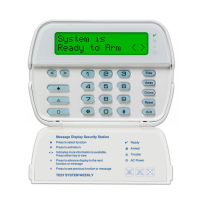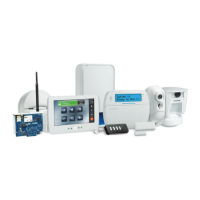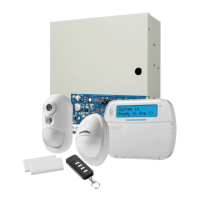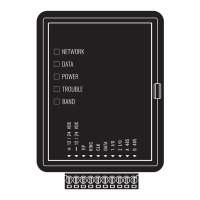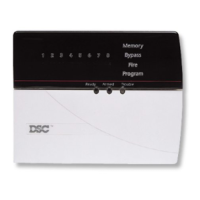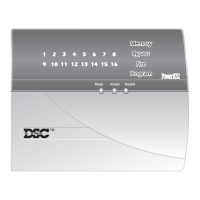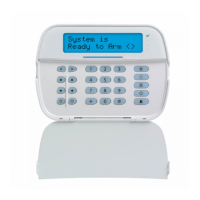2 Installation
2 Installation
The following sections provide a thorough description of how to
wire and configure devices and zones.
2.1 Installation Steps
Read this section completely before you begin. Once you have
an overall understanding of the installation process, carefully
work through each step.
Step 1: Creating a Layout
Draw a rough sketch of the building to get an idea of where all
alarm detection devices, keypads and other modules are to be
located.
Step 2: Mounting the Panel
Begin the installation by mounting additional modules in the
cabinet using the stand-offs provided. Then, mount the cabinet
in a dry, protected area close to an unswitched AC power source
and the incoming telephone line. Before attaching the cabinet to
the wall, be sure to press the four circuit board mounting studs
into the cabinet from the back. After you have attached the cabi-
net to the wall, stick the provided DSC logo sticker on the front
of the cabinet.
Note: You must complete all wiring before connecting the bat-
tery, telephone wires and/or applying AC to the panel. Before
these operations are performed, the cabinet shall be properly
secured to the building structure.
Note: The metallic cabinet door shall be locked using a key
(lock) and minimum 2 (two) screws.
Step 3: Wiring the Keybus (Section 2.4)
Wire the Keybus to each of the modules following the guidelines
provided in Section 2.4 Keybus Operation and Wiring.
Step 4: Zone Wiring (Section 2.8)
You must power down the control panel to complete all zone
wiring. Please refer to Section 2.9 Zone Wiring when connecting
zones using normally closed loops, single EOL resistors, double
EOL resistors, Fire zones and Keyswitch Arming zones.
Step 5: Complete Wiring (Section 2.2)
Complete all other wiring including bells or sirens, telephone
line connections, and ground connections following the guide-
lines provided in Section 2.2 Terminal Descriptions.
Step 6: Powering up the Control Panel
Once all zone and Keybus wiring is complete, power up the con-
trol panel. First, connect the red battery lead to the positive ter-
minal and the black lead to negative. Then, connect the AC.
Note: Connect the battery before connecting the AC. You must
apply AC power to the panel for at least 10 seconds, or the panel
will not function. The panel will not power up on the battery
connection alone.
Step 7: Keypad Assignment (Section 2.6)
In order for keypads to be properly supervised, each must be
assigned to a different slot. Please follow the guidelines pro-
vided in Section 2.5 Current Ratings – Modules & Accessories
when assigning keypads.
Step 8: Supervision (Section 2.7)
The supervision of each module by the panel is automatically
enabled upon power up. Please verify that all modules appear on
the system according to the instructions in Section 2.6 Keypad
Assignment.
Step 9: Programming the System (Sections 4 & 5)
Section 4 Programming explains how to program the panel. Fill
out the Programming Worksheets completely before attempting
to program the system. (See Section 5 Programming Work-
sheets).
Step 10: Testing the System
Test the panel thoroughly to ensure that all features and func-
tions are operating as programmed.
2.2 Terminal Descriptions
Battery Connection
A 12V 1.2Ah, 4 Ah or 7Ah rechargeable battery is used as a
backup source of power in the event of an AC power failure.
Note: Connect the battery before connecting the AC.
Connect the RED battery lead to the positive battery terminal;
connect the BLACK lead to negative.
AC Terminals
The panel requires a 16.5VAC, 40VA transformer. Connect the
transformer to an unswitched AC source and connect the trans-
former to these terminals.
Note: Do not connect the transformer until all other wiring is
complete. The transformer secondary wire distance is as shown
below:
Note: For UL Listed installations, do NOT connect transformer
to a receptacle controlled by a switch.
AUX+ and AUX- Auxiliary Power Terminals
These terminals provide up to 550 mA of additional current at
9.6–13.8 V
DC for devices requiring power. Connect the positive
side of any device requiring power to the AUX+ terminal, the
negative side to AUX- (ground). The AUX output is protected.
This means that if too much current is drawn from these termi-
nals (such as a wiring short), the panel will temporarily shut off
the output until the problem is corrected.
Bell Output Terminals – BELL+ and BELL-
These terminals provide up to 700 mA of continuous current at
12 V
DC for powering bells, sirens, strobes or other warning-type
equipment. Connect the positive side of any alarm warning
device to BELL+, the negative side to BELL–. Please note that
the Bell output is protected: if too much current is drawn from
these terminals (such as a wiring short), the panel will shut down
the output. Two amps can be drawn for short periods only.
The Bell output is supervised. If an alarm warning device is con-
nected to the bell terminals, a termination resistor is not neces-
sary. If no alarm warning devices are in use, connect a 1000
resistor across BELL+ and BELL– to prevent a Bell Circuit
Trouble from being generated. For more information, please
refer to[*][2]Trouble Display).
AWG Feet Metres
24 5.8 1.8
22 9.3 2.8
20 14.8 4.5
18 23.5 7.2
